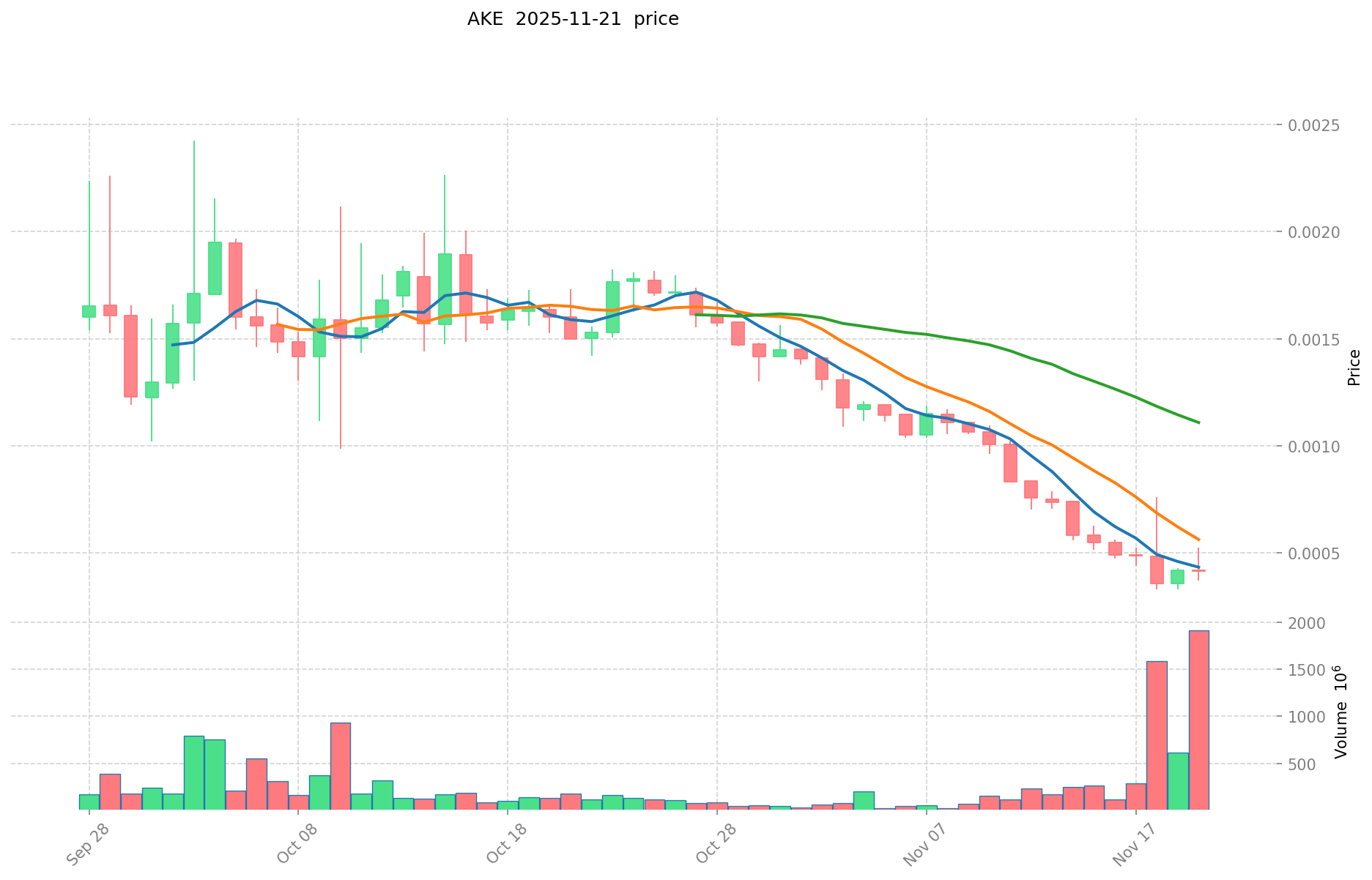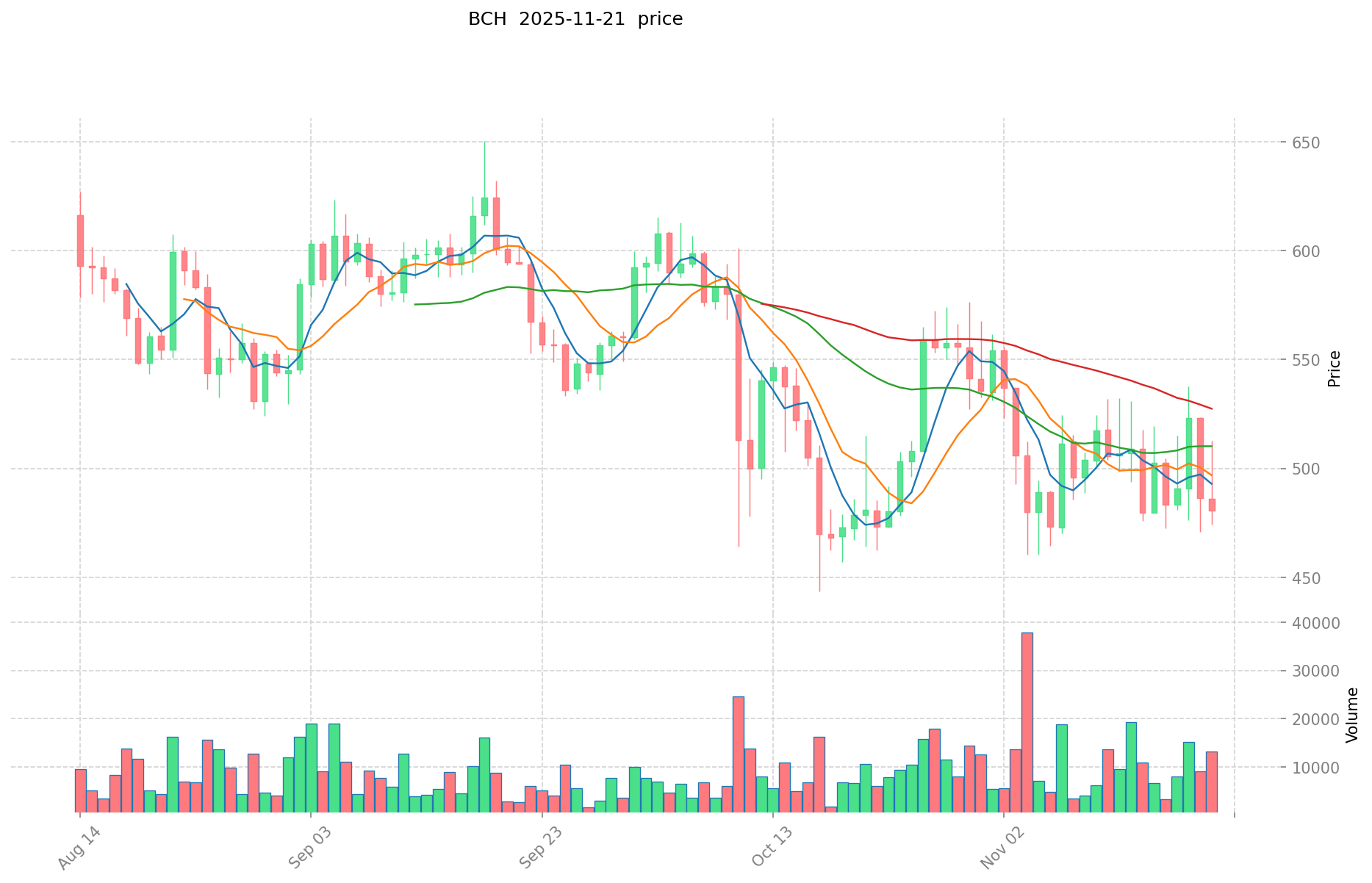AKE vs BCH: The Battle for Cryptocurrency Dominance in Southeast Asia
Introduction: Investment Comparison of AKE vs BCH
In the cryptocurrency market, the comparison between Akedo vs BitcoinCash has always been a topic that investors can't avoid. The two not only have significant differences in market cap ranking, application scenarios, and price performance, but also represent different positioning in the crypto asset space.
Akedo (AKE): Since its launch, it has gained market recognition for its vibe coding game and content creation engine leveraging AI agents.
BitcoinCash (BCH): Since its inception in 2017, it has been hailed as a Bitcoin hard fork aimed at on-chain scaling, following Satoshi's vision for global adoption.
This article will comprehensively analyze the investment value comparison between AKE vs BCH, focusing on historical price trends, supply mechanisms, institutional adoption, technological ecosystems, and future predictions, attempting to answer the question most concerning to investors:
"Which is the better buy right now?"
I. Price History Comparison and Current Market Status
AKE and BCH Historical Price Trends
- 2025: AKE reached its all-time high of $0.0024262 on October 3, followed by a significant drop to its all-time low of $0.0003286 on November 18.
- 2017: BCH was created through a hard fork of Bitcoin, with its all-time high of $3,785.82 recorded on December 20.
- Comparative analysis: In the recent market cycle, AKE experienced a sharp decline from its peak to its lowest point within a short period, while BCH has shown more stability, maintaining a price well above its all-time low of $76.93 set in December 2018.
Current Market Situation (2025-11-21)
- AKE current price: $0.0004113
- BCH current price: $476.43
- 24-hour trading volume: AKE $443,297.03 vs BCH $5,348,330.30
- Market Sentiment Index (Fear & Greed Index): 14 (Extreme Fear)
Click to view real-time prices:
- View AKE current price Market Price
- View BCH current price Market Price


II. Core Factors Affecting the Investment Value of AKE vs BCH
Supply Mechanisms (Tokenomics)
- AKE: Fixed maximum supply of 88,888,888 AKE with deflationary mechanism through burning
- BCH: Fixed maximum supply of 21 million coins with halving mechanism similar to Bitcoin
- 📌 Historical Pattern: Deflationary models like AKE's tend to create upward price pressure over time, while BCH's halving events have historically served as catalysts for market cycles.
Institutional Adoption and Market Applications
- Institutional Holdings: BCH has more established institutional presence with support from payment processors and exchanges
- Enterprise Adoption: BCH shows stronger adoption in merchant payments and cross-border transactions, while AKE is developing its position in the Web3 ecosystem
- Regulatory Attitudes: BCH generally follows similar regulatory treatment as Bitcoin in most jurisdictions, while AKE's regulatory framework is still evolving
Technological Development and Ecosystem Building
- AKE Technological Upgrades: Focusing on Akash Network's decentralized cloud computing infrastructure with recent improvements in network performance
- BCH Technological Development: Implemented smart contract functionality through SmartBCH sidechain and continues to optimize for on-chain transactions
- Ecosystem Comparison: BCH has a more mature payment ecosystem, while AKE is building specialized infrastructure for decentralized computing and Web3 applications
Macroeconomic Environment and Market Cycles
- Performance During Inflation: BCH positions itself as "digital cash" with some store-of-value properties during inflation, similar to Bitcoin
- Macroeconomic Monetary Policy: Both assets tend to respond to Federal Reserve policies, with interest rate cuts generally benefiting the broader crypto market
- Geopolitical Factors: BCH may benefit more from cross-border transaction demands due to its focus on payments, while AKE's utility is more tied to decentralized computing demand
III. 2025-2030 Price Prediction: AKE vs BCH
Short-term Prediction (2025)
- AKE: Conservative $0.000301636 - $0.0004132 | Optimistic $0.0004132 - $0.000566084
- BCH: Conservative $242.4846 - $475.46 | Optimistic $475.46 - $580.0612
Mid-term Prediction (2027)
- AKE may enter a growth phase, with estimated prices ranging from $0.0003688718007 to $0.0007679789949
- BCH may enter a consolidation phase, with estimated prices ranging from $320.29790814 to $659.4368697
- Key drivers: Institutional capital inflow, ETF, ecosystem development
Long-term Prediction (2030)
- AKE: Base scenario $0.00076978563525 - $0.000877555624185 | Optimistic scenario $0.000877555624185+
- BCH: Base scenario $542.4840451638972 - $743.12882899164 | Optimistic scenario $743.12882899164 - $787.7165587311384
Disclaimer: The information provided is for informational purposes only and should not be considered financial advice. Cryptocurrency markets are highly volatile and unpredictable. Always conduct your own research before making any investment decisions.
AKE:
| 年份 | 预测最高价 | 预测平均价格 | 预测最低价 | 涨跌幅 |
|---|---|---|---|---|
| 2025 | 0.000566084 | 0.0004132 | 0.000301636 | 0 |
| 2026 | 0.00071977374 | 0.000489642 | 0.00042598854 | 18 |
| 2027 | 0.0007679789949 | 0.00060470787 | 0.0003688718007 | 46 |
| 2028 | 0.000830475553264 | 0.00068634343245 | 0.000528484442986 | 65 |
| 2029 | 0.000781161777643 | 0.000758409492857 | 0.000659816258785 | 83 |
| 2030 | 0.000877555624185 | 0.00076978563525 | 0.000715900640782 | 86 |
BCH:
| 年份 | 预测最高价 | 预测平均价格 | 预测最低价 | 涨跌幅 |
|---|---|---|---|---|
| 2025 | 580.0612 | 475.46 | 242.4846 | 0 |
| 2026 | 728.309628 | 527.7606 | 401.098056 | 10 |
| 2027 | 659.4368697 | 628.035114 | 320.29790814 | 31 |
| 2028 | 695.234871198 | 643.73599185 | 502.114073643 | 35 |
| 2029 | 816.77222645928 | 669.485431524 | 482.02951069728 | 40 |
| 2030 | 787.7165587311384 | 743.12882899164 | 542.4840451638972 | 55 |
IV. Investment Strategy Comparison: AKE vs BCH
Long-term vs Short-term Investment Strategy
- AKE: Suitable for investors focused on Web3 ecosystem potential and decentralized computing
- BCH: Suitable for investors seeking established payment networks and potential store of value
Risk Management and Asset Allocation
- Conservative investors: AKE 20% vs BCH 80%
- Aggressive investors: AKE 60% vs BCH 40%
- Hedging tools: Stablecoin allocation, options, cross-currency portfolios
V. Potential Risk Comparison
Market Risk
- AKE: Higher volatility due to lower market cap and trading volume
- BCH: Susceptible to broader cryptocurrency market trends and Bitcoin price movements
Technical Risk
- AKE: Scalability, network stability
- BCH: Mining centralization, potential security vulnerabilities
Regulatory Risk
- Global regulatory policies may have differing impacts on both assets
VI. Conclusion: Which Is the Better Buy?
📌 Investment Value Summary:
- AKE advantages: Deflationary model, potential growth in decentralized computing market
- BCH advantages: Established payment network, Bitcoin fork with larger community
✅ Investment Advice:
- New investors: Consider a balanced approach with higher allocation to BCH for stability
- Experienced investors: Explore AKE for potential high growth, maintain BCH for diversification
- Institutional investors: Evaluate BCH for payment solutions, monitor AKE's ecosystem development
⚠️ Risk Warning: Cryptocurrency markets are highly volatile. This article does not constitute investment advice. None
VII. FAQ
Q1: What are the main differences between AKE and BCH in terms of investment potential? A: AKE offers a deflationary model with potential growth in the decentralized computing market, while BCH provides an established payment network and benefits from being a Bitcoin fork with a larger community.
Q2: How do the supply mechanisms of AKE and BCH compare? A: AKE has a fixed maximum supply of 88,888,888 tokens with a deflationary mechanism through burning. BCH has a fixed maximum supply of 21 million coins with a halving mechanism similar to Bitcoin.
Q3: Which cryptocurrency is more suitable for long-term investment? A: BCH may be more suitable for long-term investors seeking established payment networks and potential store of value, while AKE might appeal to those focused on Web3 ecosystem potential and decentralized computing.
Q4: How do institutional adoption and market applications differ between AKE and BCH? A: BCH has more established institutional presence with support from payment processors and exchanges, and shows stronger adoption in merchant payments and cross-border transactions. AKE is still developing its position in the Web3 ecosystem.
Q5: What are the predicted price ranges for AKE and BCH by 2030? A: For AKE, the base scenario predicts $0.00076978563525 - $0.000877555624185, with an optimistic scenario above $0.000877555624185. For BCH, the base scenario predicts $542.4840451638972 - $743.12882899164, with an optimistic scenario of $743.12882899164 - $787.7165587311384.
Q6: How should investors allocate their portfolio between AKE and BCH? A: Conservative investors might consider allocating 20% to AKE and 80% to BCH, while aggressive investors might opt for 60% AKE and 40% BCH. However, individual circumstances and risk tolerance should always be considered.
Q7: What are the main risks associated with investing in AKE and BCH? A: AKE faces higher volatility due to lower market cap and trading volume, as well as potential scalability and network stability issues. BCH is susceptible to broader cryptocurrency market trends, Bitcoin price movements, and potential mining centralization risks. Both are subject to regulatory risks.
Share
Content